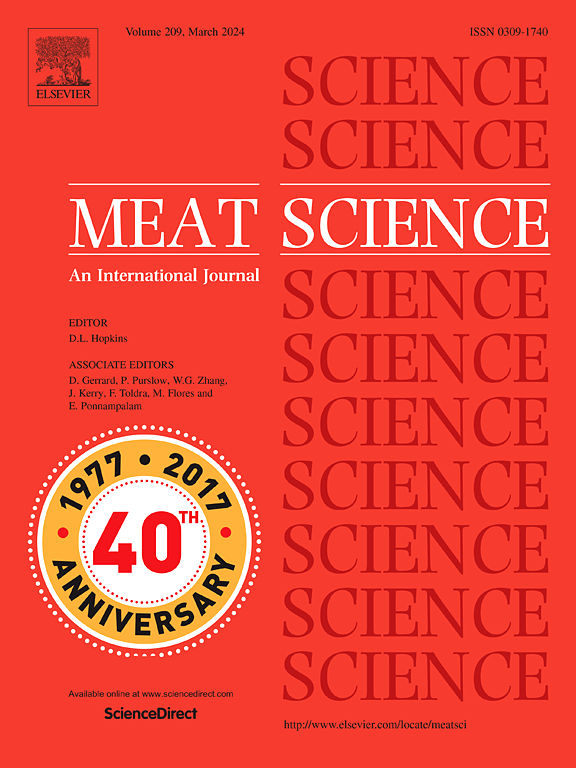Yellow mealworm as an alternative to conventional plant- and animal-based protein sources in feedlot lambs' diets: Implications on blood parameters, growth and slaughter performance, carcass traits, and meat quality
IF 6.1
1区 农林科学
Q1 Agricultural and Biological Sciences
引用次数: 0
Abstract
This study evaluates the effects of Tenebrio molitor meal (TMM) as an alternative to conventional plant-based (soybean meal, SBM) and animal-based (fishmeal, FM) protein sources on blood parameters, growth and slaughter performance, carcass traits, and meat quality of feedlot lambs. A total of 24 Suffolk lambs [3 months of age, 21.4 ± 1.08 kg body weight (BW)] were allocated for 60 days to three treatments (8 lambs per treatment) in a completely randomized design, as follows: 1- SBM at 150 g/kg dry matter (DM)], 2- FM at 50 g/kg DM, and 3- TMM at 60 g/kg DM. Feed intake, BW, and blood samples were collected on days 0, 20, 40, and 60. At the end of the trial, the lambs were slaughtered for carcass evaluation and meat quality assessment. The average daily gain was higher for SBM-fed than for TMM-fed lambs (0.25 and 0.21 kg/d; P < 0.001). Plasma levels of creatinine were higher in FM-fed when compared to SBM-fed lambs, while TMM-fed lambs showed intermediate values (88.72, 85.69 and 87.57 μmol/L, respectively; P < 0.05). The hot and cold carcass weights (15.99 and 15.52 kg vs 18.49 and 18.03 kg) and yields (44.31 and 43.02 % vs 46.03 and 44.87 %) were lower in the TMM group compared with the SBM group (P < 0.05). The dietary treatment had no effect (P > 0.05) on meat pH, color, texture, water loss and contents of fat, protein, and moisture. Further research should evaluate optimal inclusion levels of TMM in combination with conventional protein sources to avoid negative economic implications.
黄粉虫作为饲育羔羊日粮中传统植物和动物蛋白质来源的替代品:对血液参数、生长和屠宰性能、胴体性状和肉品质的影响
本研究评价了粉黄粉(TMM)作为传统植物蛋白(豆粕、豆粕)和动物蛋白(鱼粉、鱼粉)的替代品对饲用羔羊血液参数、生长和屠宰性能、胴体性状和肉品质的影响。试验选用24只[3月龄,体重21.4±1.08 kg]的萨福克羔羊,采用完全随机设计,分为3个处理(每个处理8只羊),分别为:1- SBM(干物质为150 g/kg), 2- FM(干物质为50 g/kg), 3- TMM(干物质为60 g/kg),于第0、20、40和60天采集采食量、体重和血液样本。试验结束后,屠宰羔羊进行胴体评价和肉质评价。sbm饲羔羊的平均日增重高于tmm饲羔羊(0.25和0.21 kg/d;P & lt;0.001)。fm饲羔羊血浆肌酐水平高于sbm饲羔羊,而tmm饲羔羊血浆肌酐水平居中,分别为88.72、85.69和87.57 μmol/L;P & lt;0.05)。TMM组冷热胴体重(15.99和15.52 kg vs 18.49和18.03 kg)和产量(44.31和43.02% vs 46.03和44.87%)低于SBM组(P <;0.05)。饮食处理无明显效果(P >;0.05)对肉的pH值、颜色、质地、失水、脂肪、蛋白质和水分含量的影响。进一步的研究应该评估TMM与传统蛋白质来源结合的最佳包涵水平,以避免负面的经济影响。
本文章由计算机程序翻译,如有差异,请以英文原文为准。
求助全文
约1分钟内获得全文
求助全文
来源期刊

Meat Science
工程技术-食品科技
CiteScore
12.60
自引率
9.90%
发文量
282
审稿时长
60 days
期刊介绍:
The aim of Meat Science is to serve as a suitable platform for the dissemination of interdisciplinary and international knowledge on all factors influencing the properties of meat. While the journal primarily focuses on the flesh of mammals, contributions related to poultry will be considered if they enhance the overall understanding of the relationship between muscle nature and meat quality post mortem. Additionally, papers on large birds (e.g., emus, ostriches) as well as wild-captured mammals and crocodiles will be welcomed.
 求助内容:
求助内容: 应助结果提醒方式:
应助结果提醒方式:


